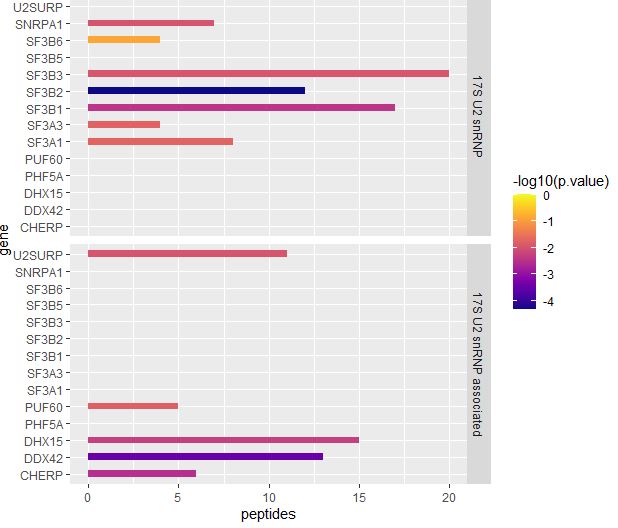Tom3
February 17, 2021, 11:07pm
1
Hello together,
this is my code:
ggplot(XLINKFORR,aes(x=gene,y=peptides,fill=-log10(p.value))) +
This is my plot
My Problem is that in the Plot all genes are repeated (U2SURP - CHERP), but only CHERP
See the FAQ: How to do a minimal reproducible example reprex for beginners . Questions like this are much easier to troubleshoot, and far more likely to attract useful answers, with a complete reprex, including representative data.
Here is one approach
(XLINKFORR <- data.frame(
gene=factor(letters[c(1,2,1,3)]),
family=c(1,1,2,2),
peptides=c(12,21,31,14),
p.value=(1:4)/40
))
library(viridis)
library(tidyverse)
(virid_scale_extent <- range(-log10(XLINKFORR$p.value)))
# ggplot(XLINKFORR,aes(x=gene,y=peptides,fill=-log10(p.value))) +
# geom_col(position="stack",width=0.4)+
# coord_flip() + scale_fill_viridis(option="plasma",limits=virid_scale_extent)+
# facet_grid(family~.)
#
(split_df <- XLINKFORR %>%
group_by(family) %>%
group_split())
split_df_recode <- map(split_df,~mutate(.,
gene=factor(gene)))
library(cowplot)
base_plot_func <- function(x){
ggplot(x,aes(x=gene,y=peptides,fill=-log10(p.value))) +
geom_col(position="stack",width=0.4) +
coord_flip() + scale_fill_viridis(option="plasma",
,limits=virid_scale_extent)
}
plots <- purrr::map(split_df_recode,
~{base_plot_func(.x) +
theme(legend.position = "none")
})
g1 <- plot_grid(plotlist=plots,
labels=unique(XLINKFORR$family),
nrow = 2)
# extract the legend from one of the plots
legend <- get_legend(
# create some space to the left of the legend
base_plot_func(split_df_recode[[1]]) + theme(legend.box.margin = margin(0, 0, 0, 12))
)
# add the legend to the row we made earlier. Give it one-third of
# the width of one plot (via rel_widths).
plot_grid(g1, legend, rel_widths = c(6,1))
Tom3
February 18, 2021, 2:07am
4
Thank you very much, it works! Really a big help for me - will take me a while to really understand the process but your comments help.
p.s. sorry for not shortening my question to an example
Tom3
February 18, 2021, 4:00pm
5
Additional question:
system
March 11, 2021, 4:00pm
6
This topic was automatically closed 21 days after the last reply. New replies are no longer allowed.
